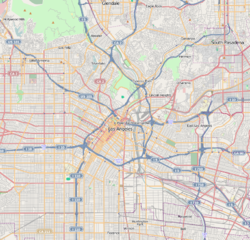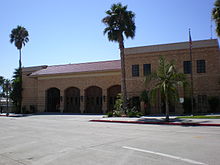| Hollywood | |
|---|---|
| Neighborhood of Los Angeles | |

|
|
 Map of the Hollywood neighborhood of Los Angeles, as delineated by the Los Angeles Times |
|
| Location within Central Los Angeles | |
| Coordinates: 34°6′0″N 118°20′0″W |
Hollywood (/ˈhɒliwʊd/ hol-ee-wuud) is a neighborhood in the central region of Los Angeles, California. It is notable for its place as the home of the entertainment industry, including several of its historic studios. Its name has come to be a metonym for the motion picture industry of the United States. Hollywood is also a highly ethnically diverse, densely populated, economically diverse neighborhood and retail business district.
Hollywood was a small community in 1870 and was incorporated as a municipality in 1903.[1][2] It officially merged with the city of Los Angeles in 1910, and soon thereafter a prominent film industry began to emerge, eventually becoming the most dominant and recognizable in the world.
History.
Early history and development.
In 1853, one adobe hut stood in Nopalera (Nopal field), named for the Mexican Nopal cactus indigenous to the area. By 1870, an agricultural community flourished. The area was known as the Cahuenga Valley, after the pass in theSanta Monica Mountains immediately to the north.
There are differing opinions as to the true origin of the name "Hollywood." According to the diary of H. J. Whitley, known as the "Father of Hollywood", on his honeymoon in 1886 he stood at the top of the hill looking out over the valley. Along came a Chinese man in a wagon carrying wood. The man got out of the wagon and bowed. The Chinese man was asked what he was doing and replied, "I holly-wood", meaning 'hauling wood.' HJ Whitley had an epiphany and decided to name his new town Hollywood. Holly would represent England and wood would represent his Scottish heritage. Whitley had already started over 100 towns across the western United States. [5][6] The name is also a reference to theToyon, a native plant with bright red winter berries that resemble holly.[7] Originally the name "Figwood" was to be used to name the area due to the surrounding number of fig trees. Whitley arranged to buy the 500-acre (2.0 km2) E.C. Hurd ranch and disclosed to him his plans for the land. They agreed on a price and Hurd agreed to sell at a later date. Before Whitley got off the ground with Hollywood, plans for the new town had spread to General Harrison Gray Otis, Hurd's wife, eastern adjacent ranch co-owner Daeida Wilcox, and others.
An alternate derivation for the name comes from histories on Hollywood, Illinois (now part of Brookfield, IL) and Hollywood, Florida. Mrs. Wilcox was said to have met a woman on a train trip to the East. The woman told Mrs. Wilcox about her lovely ranch in Hollywood, Illinois. Mrs. Wilcox was said to be so enamored of the name that she appropriated it for the property she and her husband Harvey were planning in the Cahuenga Valley, as it was then known. Further research yielded that a parcel of land in Illinois was, in fact named Hollywood and was owned by John D. Rockefeller and his wife, Laura. When their fourth daughter Edith married Harold McCormick, heir to the farming equipment fortune in 1895, John D. and Laura Rockefeller gifted the ranch to her. The lower part of the area known as Hollywood was purchased by a Samuel Gross in 1893 who subdivided the property for housing and development. Mrs. McCormick donated her parcel of Hollywood to the Cook County Forest Preserve District for development as a zoological garden in 1919 and it is now the Brookfield Zoo. Often this story is repeated as Mrs. Wilcox having met Mrs. McCormick, but as the Wilcoxes filed the name with the City of Los Angeles in 1887. when Mrs. McCormick was but 15, the woman Mrs. Wilcox met was her mother, Mrs. Rockefeller, who owned the property with her husband, John D. Rockefeller.[8][9]

Daeida Wilcox may have learned of the name Hollywood from Ivar Weid, her neighbor in Holly Canyon (now Lake Hollywood) and a prominent investor and friend of Whitley's.[10][11] She recommended the same name to her husband,Harvey. H. Wilcox. On August 1887, Wilcox filed a deed and parcel map of property he sold with the Los Angeles County Recorder's office, named "Hollywood, California." [12][13] Wilcox wanted to be the first to record it on a deed. The early real-estate boom busted that same year, yet Hollywood began its slow growth.
By 1900, the region had a post office, newspaper, hotel, and two markets. Los Angeles, with a population of 102,479[14] lay 10 miles (16 km) east through the vineyards, barley fields, and citrus groves. A single-track streetcar line ran down the middle of Prospect Avenue from it, but service was infrequent and the trip took two hours. The old citrus fruit-packing house was converted into a livery stable, improving transportation for the inhabitants of Hollywood.

The Hollywood Hotel was opened in 1902 by H. J. Whitley, president of the Los Pacific Boulevard and Development Company. Having finally acquired the Hurd ranch and subdivided it, Whitley built the hotel to attract land buyers. Flanking the west side of Highland Avenue, the structure fronted on Prospect Avenue, which, still a dusty, unpaved road, was regularly graded and graveled. The hotel was to become internationally known and was the center of the civic and social life and home of the stars for many years.[15]
Whitley's company developed and sold one of the early residential areas, the Ocean View Tract.[16] Whitley did much to promote the area. He paid thousands of dollars for electric lighting, including bringing electricity and building a bank, as well as a road into the Cahuenga Pass. The lighting ran for several blocks down Prospect Avenue. Whitley's land was centered on Highland Avenue.[17][18]
Incorporation and merger
Hollywood was incorporated as a municipality on November 14, 1903, by a vote of 88 for and 77 against. On January 30, 1904, the voters in Hollywood decided, by a vote of 113 to 96, for the banishment of liquor in the city, except when it was being sold for medicinal purposes. Neither hotels nor restaurants were allowed to serve wine or liquor before or after meals.[19]
In 1910, the city voted for merger with Los Angeles in order to secure an adequate water supply and to gain access to the L.A. sewer system. With annexation, the name of Prospect Avenue changed to Hollywood Boulevard and all the street numbers were also changed.[20]
Motion picture industry
By 1912, major motion-picture companies had set up production near or in Los Angeles.[21] In the early 1900s, most motion picture patents were held by Thomas Edison's Motion Picture Patents Company in New Jersey, and filmmakers were often sued to stop their productions. To escape this, filmmakers began moving out west, where Edison's patents could not be enforced.[22] Also, the weather was ideal and there was quick access to various settings. Los Angeles became the capital of the film industry.[23]
Director D. W. Griffith was the first to make a motion picture in Hollywood. His 17-minute short film In Old California (1910) was filmed for the Biograph Company.[24][25][26] Although Hollywood banned movie theaters—of which it had none—before annexation that year, Los Angeles had no such restriction.[27] The first film by a Hollywood studio, Nestor Motion Picture Company, was shot on October 26, 1911.[28] The Whitley home was used as its set, and the unnamed movie was filmed in the middle of their groves at the corner of Whitley Avenue and Hollywood Boulevard.[29]
The first studio in Hollywood, the Nestor Company, was established by the New Jersey–based Centaur Company in aroadhouse at 6121 Sunset Boulevard (the corner of Gower), in October 1911.[30] Four major film companies – Paramount,Warner Bros., RKO, and Columbia – had studios in Hollywood, as did several minor companies and rental studios. In the 1920s, Hollywood was the fifth largest industry in the nation.[23]
Hollywood became known as Tinseltown[31] and Movie Biz City because of the glittering image of the movie industry. Hollywood has since become a major center for film study in the United States.
The name "Hollywood" is often applied to any film or TV production location within Greater Los Angeles, whether or not it is physically located within Hollywood. For example, from the time it relocated from New York in 1972 until its host retired in 1992, The Tonight Show Starring Johnny Carson was announced as being broadcast "from Hollywood" when in truth it originated from a studio facility in Burbank, California. Similarly, Metro-Goldwyn-Mayer's storied film studio facility, associated with the Golden Age of Hollywood (and today known as Sony Pictures Studios) is actually located in Culver City, a number of miles from Hollywood. Today, only two of the six major film studios are actually based in Los Angeles, and only one of them, Paramount, is still located in Hollywood.[citation needed]
Development
During the early 1950 the Hollywood Freeway was constructed through the northeast corner of Hollywood.
The Capitol Records Building on Vine Street, just north of Hollywood Boulevard, was built in 1956, and the Hollywood Walk of Fame was created in 1958 as a tribute to artists and other significant contributors to the entertainment industry. The official opening was on February 8, 1960.[32][33]
The Hollywood Boulevard Commercial and Entertainment District was listed in the National Register of Historic Places in 1985.
In June 1999, the Hollywood extension of the Los Angeles County Metro Rail Red Linesubway opened from Downtown Los Angeles to the San Fernando Valley, with stops along Hollywood Boulevard at Western Avenue(Hollywood/Western Metro station), Vine Street (Hollywood/Vine Metro station), and Highland Avenue (Hollywood/Highland Metro station).
The Dolby Theatre, which opened in 2001 as the Kodak Theatre at the Hollywood & Highland Center mall, is the home of theOscars. The mall is located where the historic Hollywood Hotel once stood.
Revitalization
After years of serious decline in the 1980s, many Hollywood landmarks were threatened with demolition.[34] Columbia Square, at the northeast corner of Sunset Boulevard and Gower Street, is part of the ongoing rebirth of Hollywood. The Art Deco-style studio complex completed in 1938, which was once the legendary Hollywood headquarters for CBS, became home to a new generation of popular broadcasters when cable television networks MTV, Comedy Central, BET and Spike TV consolidated their offices here in 2014 as part of a $420-million office, residential and retail complex.[35]
| This section requires expansionwith: ongoing revitalization supported by city but various neighborhood groups opposed to dense development have won several major court victories. (May 2015) |
Since 2000, Hollywood has been increasingly gentrified due to revitalization by private enterprise and public planners.[36][37][38]
Secession movement
In 2002, some Hollywood voters began a campaign for the area to secede from Los Angeles and become a separate municipality. In June of that year, the Los Angeles County Board of Supervisors placed secession referendums for both Hollywood and the San Fernando Valley on the ballot. To pass, they required the approval of a majority of voters in the proposed new municipality as well as a majority of voters in all of Los Angeles. In the November election, both referendums failed by wide margins in the citywide vote.[39]
Geography
According to the Mapping L.A. project of the Los Angeles Times, Hollywood is flanked by Hollywood Hills to the north, Los Feliz to the northeast, East Hollywood to the east, Larchmont and Hancock Park to the south, Fairfax to the southwest, West Hollywood to the west and Hollywood Hills West to the northwest.[40]
Street limits of the Hollywood neighborhood are: north, Hollywood Boulevard from La Brea Avenue to the east boundary of Wattles Garden Park and Franklin Avenue between Bonita and Western avenues; east, Western Avenue; south, Melrose Avenue, and west, La Brea Avenue or the West Hollywood city line.[41][42]
In 1918, H. J. Whitley commissioned architect A. S. Barnes to design Whitley Heights as a Mediterranean-style village on the hills above Hollywood Boulevard, and it became the first celebrity community.[43][44][45]
Other areas within Hollywood are Franklin Village, Little Armenia, Spaulding Square and Thai Town.[41]
The famous Hollywood Sign on Mount Lee is not actually in Hollywood but is instead to the north in the Hollywood Hills.[41]
Adjacent neighborhoods
Relation of Hollywood to nearby communities:[40][42]
 |
Hollywood Hills West | Hollywood Hills | Los Feliz |  |
| West Hollywood | East Hollywood | |||
|
||||
| Fairfax | Larchmont and Hancock Park | East Hollywood |
Demographics
The 2000 U.S. census counted 77,818 residents in the 3.51-square-mile Hollywood neighborhood—an average of 22,193 people per square mile, the seventh-densest neighborhood in all of Los Angeles County. In 2008 the city estimated that the population had increased to 85,489. The median age for residents was 31, about the city's average.[41]
Hollywood was said to be "highly diverse" when compared to the city at large. The ethnic breakdown in 2000 was: Latino or Hispanic, 42.2%, Non-Hispanic Whites, 41%; Asian, 7.1%; blacks, 5.2%, and others, 4.5%.[41] Mexico (21.3%) and Guatemala (13%) were the most common places of birth for the 53.8% of the residents who were born abroad, a figure that was considered high for the city as a whole.[41]
The median household income in 2008 dollars was $33,694, considered low for Los Angeles. The average household size of 2.1 people was also lower than the city norm. Renters occupied 92.4% of the housing units, and home- or apartment owners the rest.[41]
The percentages of never-married men (55.1%), never-married women (39.8%) and widows (9.6%) were among the county's highest. There were 2,640 families headed by single parents, about average for Los Angeles.[41]
In 2000, there were 2,828 military veterans, or 4.5%, a low rate for the city as a whole.[41] These were the ten neighborhoods or cities in Los Angeles County with the highest population densities, according to the 2000 census, with the population per square mile:[46]
- Koreatown, Los Angeles, 42,611
- Westlake, Los Angeles, 38,214
- East Hollywood, Los Angeles, 31,095
- Pico-Union, Los Angeles, 25,352
- Maywood, California, 23,638
- Harvard Heights, Los Angeles, 23,473
- Hollywood, Los Angeles, 22,193
- Walnut Park, California, 22,028
- Palms, Los Angeles, 21,870
- Adams-Normandie, Los Angeles, 21,848
Radio and television

KNX was the last radio station to broadcast from Hollywood, before it left CBS Columbia Square for a studio in the Miracle Mile in 2005.
On January 22, 1947, the first commercial television station west of the Mississippi River, KTLA, began operating in Hollywood. In December of that year, The Public Prosecutor became the first network television series to be filmed in Hollywood.Television stations KTLA and KCET, both on Sunset Boulevard, are the last broadcasters (television or radio) with Hollywood addresses, but KCET has since sold its studios on Sunset and plans to move to another location. KNBC moved in 1962 from the former NBC Radio City Studios at the northeast corner of Sunset Boulevard and Vine Street to NBC Studios in Burbank. KTTV moved in 1996 from its former home at Metromedia Square on Sunset Boulevard to West Los Angeles, and KCOP left its home on La Brea Avenue to join KTTV on the Fox lot. KCBS-TVand KCAL-TV moved from their longtime home at CBS Columbia Square on Sunset Boulevard to a new facility at CBS Studio Center in Studio City.
Government
As a neighborhood within the Los Angeles city limits, Hollywood does not have its own municipal government. There was an official, appointed by the Hollywood Chamber of Commerce, who served as an honorary "Mayor of Hollywood" for ceremonial purposes only. Johnny Grant held this position from 1980 until his death on January 9, 2008.[47]
Emergency service
The Los Angeles Police Department is responsible for police services. The Hollywood police station is at 1358 N. Wilcox Ave.
Los Angeles Fire Department operates four fire stations – Station 27, 41, 52, and 82 – in the area.
The Los Angeles County Department of Health Services operates the Hollywood-Wilshire Health Center in Hollywood.[48]
Post offic
The United States Postal Service operates the Hollywood Post Office,[49] the Hollywood Pavilion Post Office,[50] and the Sunset Post Office.[51]
Neighborhood councils
Hollywood is included within the Hollywood United Neighborhood Council (HUNC)[52] Hollywood Hills West Neighborhood Council[53][54] and the Hollywood Studio District Neighborhood Council.[55][56] Neighborhood Councils cast advisory votes on such issues as zoning, planning, and other community issues. The council members are voted in by stakeholders, generally defined as anyone living, working, owning property, or belonging to an organization within the boundaries of the council.[57]
Education
Hollywood residents aged 25 and older holding a four-year degree amounted to 28% of the population in 2000, about the same as in the county at large.[41]
Schools
Public schools are operated by the Los Angeles Unified School District (LAUSD).
Schools in Hollywood include:[58]
|
|














